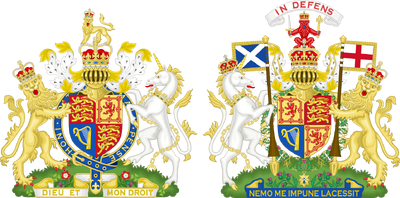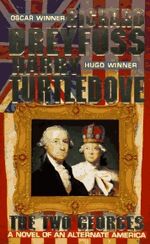
The monarch of the United Kingdom is the head of state of the United Kingdom and its overseas territories in the broader Commonwealth of Nations. There have been 12 monarchs of United Kingdom proper, although the monarchy traces its origins back to both the monarchies of the Angles and the ancient Scots kings. The Kingdom of Great Britain was formed by the Acts of Union on 1 May 1707 with the merger of the Kingdom of England and the Kingdom of Scotland, which had been in personal union under the House of Stuart since March 1603. On 1 January 1801 Great Britain merged with the Kingdom of Ireland to form the United Kingdom of Great Britain and Ireland. After most of Ireland left the union on 6 December 1922, its name was amended to the United Kingdom of Great Britain and Northern Ireland on 12 April 1927.
While the monarchy maintains formal executive authority over the country, those powers are constrained by law, precedent, and custom. For example, while the monarch appoints the prime minister, custom dictates that the monarch must appoint someone who has the support of the House of Commons. Thus, the Prime Minister's tenure in office is set by democratic election rather than by the monarch's choice. Moreover, the Prime Minister holds most of the actual power when it comes to setting and executing domestic and foreign policy.
In addition, the monarch is the Supreme Governor of the Church of England. Again, as in the secular realm, the monarch's role is more ceremonial, and the Archbishop of Canterbury is the true spiritual leader.
The monarch reigns for life. Succession is hereditary, and is governed by male-preference cognatic primogeniture. In October, 2011, the governments of the various commonwealths began the process of implementing legislation to do away with the male preference. In short order, efforts were also begun to remove the ban on Catholic rulers. Both amendments were made by the British Parliament in the Succession to the Crown Act of 2013.
This article lists the known monarchs found in the works of Harry Turtledove after the Point of Divergence in alternate history, or known monarchs found in works of science fiction. Monarchs who served before the POD of a given alternate history that are mentioned in passing do not need to be listed here. Stories set in OTL may reference past monarchs, or even the sitting monarch, but unless these works are explicitly speculative or science fiction, they do not belong here.
Southern Victory
| № |
Monarch | Reign | |
|---|---|---|---|
| 7 | Victoria | 
|
1837-1901 |
| 8 | Edward VII | 
|
1901-1910 |
| 9 | George V | 
|
1910-1936 |
| 10 | Edward VIII | 
|
1936-incumbent at series' end, 1945 |
The reign of Victoria saw Britain intervene in North America twice in a generation. In 1862, Britain recognised the independence of the Confederate States, and forced a mediation upon the United States, bringing the War of Secession to a close. In 1881, Britain participated in the Second Mexican War, attacking the USA on several fronts, and annexing a part of Maine into Canada when the conflict ended in 1882.
However, the UK's participation in the Great War (in the reign of George V) and the Second Great War (in the reign of Edward VIII) proved disastrous for the country, as Britain was defeated both times, and devastated with superbombs in the last one.
The Two Georges
| № |
Monarch | Reign | |
|---|---|---|---|
| 4 | George III | 
|
1760-1820 |
| 5 | George IV (presumed) |

|
1820-1830 |
| 6 | William IV (presumed) |

|
1830-1837 |
| 7 | Victoria | 
|
1837-1901 |
| 8 | Edward VII (presumed) |

|
1901-1910 |
| 9 | George V (presumed) |

|
1910-1936 |
| 10 | Edward VIII | 
|
1936-1972(?) |
| 11(?) | Edward IX | 
|
1972-1985 (dates estimated) |
| 12(?) | Charles III | 
|
1985(?)-incumbent at novel's end, 1995 |
In the mid-1760s, King George III met with an American delegation led by Colonel George Washington. The meeting led to an agreement on colonial self-rule within the British Empire averted a feared revolution of the colonies against Great Britain, and led to the foundation of the North American Union. A famous painting commemorated this event.
The Union continued as a proud part of the Empire, naming its capital after Queen-Empress Victoria. In 1995, a plot by a separatist insurrection was thwarted in the capital, and the life of the visiting King-Emperor Charles III was saved.
Literary comment
Only three 20th-century monarchs are named. Edward VIII and Edward IX are mentioned only in passing, while Charles III appears directly in the present day, 1995. Edward VIII is implied to have had a long reign. Assuming that Edward VIII took the throne in 1936 as in OTL, the compact timeline leaves little room for any additional monarchs.
Other Monarchs
In addition to the above, George III is referenced as the reigning monarch for part of the Atlantis series.
In addition to the above, Victoria is referenced as the reigning monarch in The Guns of the South and part of the Atlantis series.
George VI is referenced as the reigning monarch in Joe Steele, Worldwar, and The War That Came Early.
Elizabeth II is referenced as the reigning monarch in both Colonization and "Hindsight".
In In the Presence of Mine Enemies, the otherwise unidentified Henry IX reigns in the early 2010s.
In Curious Notions, a unnamed king reigns over Great Britain (or perhaps just England - the novel is vague about this point) in 2096.
Historical Monarchs in Non-Monarchical Roles
Edward VII is referenced as the incumbent Prince of Wales in the standalone novel The Guns of the South and the Atlantis story "The Scarlet Band".
See Also
- Prime Minister of the United Kingdom, the head of government and senior most elected position in the United Kingdom. In truth, the Prime Minister actually makes most of the important decisions for the country, with the monarch acting as a figurehead.
| |||||||||||||||||||||||
| |||||||||||||||||||||||||











